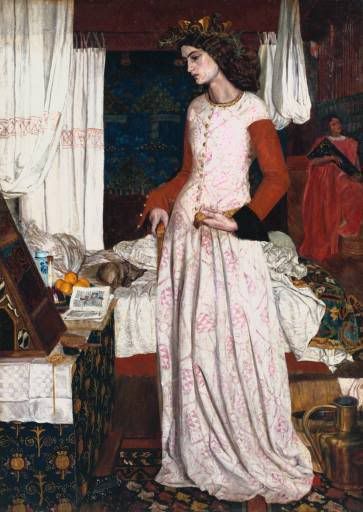If you haven't already seen it, take a moment to visit Stephanie Pina's Lizzie Siddal blog to read Little Journeys to the Homes of Great Lovers: Rossetti and Siddal. Stephanie found a 14 volume set of Elbert Hubbard's Little Journeys at a local bookshop and she's taken the time to transcribe and scan Hubbard's rendition of the story of Dante Gabriel Rossetti and Elizabeth Siddal. I had a wonderful time reading it - it's a charming and entertaining version of the story. I found Hubbard's non-judgmental approach to Rossetti quite refreshing (you could say he tries a little too hard to make excuses for him, but I think Rossetti has enough critics). The story can also be found in Volume 13 of Hubbard's Little Journeys, which is available on Project Gutenberg (along with a number of his other writings).
Those of you who are familiar with the Arts and Crafts movement in the United States will recognize Elbert Hubbard as one of the founders of the Roycrofters and the Roycroft Press. (His magazine, The Philistine, which was published by the Roycroft Press, is nearly as well known as the The Germ). Hubbard was heavily influenced by William Morris' philosophy of the Arts and Crafts movement, and the Roycroft community in East Aurora, New York, was probably the most ardent attempt to see Morris' socialist vision put into practice in the real world. His art colony may not have survived, but his writings remain available to readers as a window into his world.
Saturday, August 7, 2010
Elbert Hubbard's Little Journeys
Posted by
Margaret
at
8:35 AM
4
comments
![]()
![]()
Labels: arts and crafts, lizzie siddal, pre-raphaelites, rossetti, william morris
Saturday, July 31, 2010
"Useful and Beautiful" Conference at the University of Delaware Announced
The University of Delaware has announced a conference entitled "Useful and Beautiful: The Transatlantic Arts of William Morris and the Pre-Raphaelites." The conference will run between October 7-9 at the University of Delaware, the Delaware Art Museum, and the Winterthur Museum. This sounds like such an exciting conference. Unfortunately, I won't be able to attend, but I hope that some readers will go and report back!
The conference, which has been organized together with the William Morris Society in the United States, will take feature rare books and manuscripts from the University's holdings, as well as fine and decorative arts from the Delaware Art Museum. The keynote speaker for the conference will be Fred Kaplan, Professor Emeritus of English at Queens College and the Graduate Centre of the City University of New York. His address will be held Thursday, October 7, at 4:30 p.m. in the Reserve Room of the Morris Library. Dr. Kaplan has written a number of biographies,including The Singular Mark Twain; Gore Vidal; Henry James: The Imagination of Genius; Charles Dickens; Thomas Carlyle(finalist for the National Book Critics Circle Award and the Pulitzer Prize); and, most recently,Lincoln: The Biography of a Writer. His lecture, entitled “Useful and Beautiful: Henry James and Mark Twain,” is sponsored by the University of Delaware Library Associates and associated with the exhibition, London Bound: American Writers in Britain, 1870–1916, at the University of Delaware Library.
In addition to the keynote address, there will be numerous sessions by internationally recognized scholars and specialists in Pre-Raphaelite Art, and a special performance of Oscar Wilde's The Importance of Being Earnest by the University of Delaware's critically acclaimed Resident Ensemble Players/Professional Theatre Training Program.
For more information, contact Mark Samuels Lasner, Senior Research Fellow, University of Delaware Library by email at: marksl@udel.edu, (302) 831-3250; or visit them on the web www.udel.edu/conferences/uandb
The conference is priced at $150 per person, and $75 for students. There is no charge for University of Delaware faculty, students and staff.
Posted by
Margaret
at
12:28 PM
5
comments
![]()
![]()
Labels: art deco, art nouveau, arts and crafts, news, pre-raphaelites, william morris
Thursday, May 6, 2010
Utopia Matters: from Brotherhoods to Bauhaus
From May 1 - July 25, 2010, the Guggenheim museum in Venice will be presenting "Utopia Matters: From Brotherhoods to Bauhaus." The exhibit is headed by Vivien Greene, who curates the 19th and early 20th century Art at the Guggenheim Museum in New York.
Utopia Matters will examine "the evolution of utopian ideas in modern Western artistic thought and practice" and features over 70 works of art drawn from the decorative arts, design, photography, paintings and sculpture. A broad spectrum of historical Utopian art movements will be examined, including the Pre-Raphaelite Brotherhood, Primitivism, the German Nazarenes, William Morris and the Arts and Crafts movement, Neo-Impressionism, De Stijl, Bauhaus and Constructivism. The exhibit will end with works from the 1930s, when the Bauhaus was closed.
If you haven't noticed (the title of this blog is pretty much a dead giveaway), I'm quite the fan of Utopian artistic movements, so this is one exhibit I would dearly love to see. I've always been fascinated by the intersection of art and idealism, and there are countless fascinating historical examples of artistic groups and individuals who have sought to improve life through art.
Utopia Matters was first seen from January 22-April 11, 2010 at the Deutsche Guggenheim Berlin, so if you were lucky enough to attend that exhibit, be sure to leave a comment and let us know what you thought! I'm afraid a trip to Venice before July probably isn't in the cards for me, but I would love to hear what others have to say about their visits.
Image is Piet Mondrian's Composition 10, courtesy Wikimedia.
Posted by
Margaret
at
7:39 AM
7
comments
![]()
![]()
Labels: arts and crafts, museums, news, pre-raphaelites, william morris
Friday, March 26, 2010
Christopher Dresser: Industrial Design Pioneer
Considered by some to be the first industrial designer, Christopher Dresser (1834-1904) was a contemporary of William Morris and is best known for popularizing Japanese minimalism in the West. A designer who had also been trained as a botanist, Dresser was drawn to the simplicity and natural inspiration of Japanese design. Like Morris, Dresser was dissatisfied with the excessive ornamentation used in Victorian design. However, when it came to applying technology to design, Dresser and Morris parted ways.
As you may recall, Morris was highly suspect of any sort of technology that removed production from the hands of the craftsman. While Morris' low-tech approach can be considered more romantic by some, it is interesting to note that Morris himself struggled with the necessarily high price of his designs. It was not until companies like Liberty began mass producing Morris' work that it became affordable to the general public. Dresser, on the other, saw that technology would play a crucial role in design. His dedication to industrial production methods made his work more accessible and affordable.
In addition to his brilliant industrial design work, Dresser was an early champion of the notion of neutral backgrounds in interior design. After his tour of Japan, Dresser became convinced that walls and flooring should be done in neutral tones, and that bright splashes of colour should be reserved for accessories and accent pieces (Rompilla, 52).
A true innovator, Dresser's designs still seem fresh and new today. His design mantras, like "maximum effect with minimum means" continue to inspire contemporary industrial designers. Today, one of Dresser's philosophies--that design should address current needs with cutting-edge technologies--is more relevant than ever. It's surprising, then, that (unlike Morris) Dresser is not particularly well known outside of design circles. Nevertheless, his work is worth revisiting, and I hope that museums will take note! It would be wonderful to see an exhibit of his designs. Please contact me if you know of one in the works!
Photo courtesy http://designmuseum.org/design/christopher-dresser/. Please visit their website for more information, and for many more photographs of Dresser's work.
See also: Ethel Rompilla, Color for Interior Design (New York: Harry N. Abrams, Inc., 2005).
Posted by
Margaret
at
9:42 PM
5
comments
![]()
![]()
Labels: arts and crafts, christopher dresser, decorating, victorian, william morris
Friday, March 5, 2010
Ring House Nagano, Japan

I ran across the Ring House, designed by Takei-Nabeshima-Architects (TNA) the other day, and was enchanted. This blog tends to focus on the history of the Arts and Crafts movement, but I'm always on the lookout for modern design that reflects the principles of beauty, simplicity and utility that the Arts and Crafts movement celebrated.
Just looking at this lovely home is relaxing! Created from rings of glass and wood, the Ring House was completed in 2006 and has a 360-degree view of the forest. Because of the rings of windows, you are able to look directly through the house from every side to the woods beyond.
In his writings, William Morris continuously emphasised the importance of creating new architecture that celebrated the best of the simple medieval aesthetic, while discouraging historical reproductions (faux gothic and the like). In the past, I've struggled with this particular aspect of Morris' writing. After all, we've all seen pretty terrible examples of contemporary architecture. I've often asked myself, why not just reproduce things from the past that were beautiful and useful? I'm slowly coming around to a different point of view, however. In my view, the Ring House is an example of how we can live in and celebrate contemporary architecture while respecting the best of design traditions.
For more information, please visit the TNA website. Photo by Daici Ano courtesy www.worldarchitecturenews.com
Posted by
Margaret
at
1:39 PM
2
comments
![]()
![]()
Labels: architecture, arts and crafts, william morris
Thursday, December 10, 2009
“Apostles of Beauty: Arts and Crafts from Britain to Chicago”
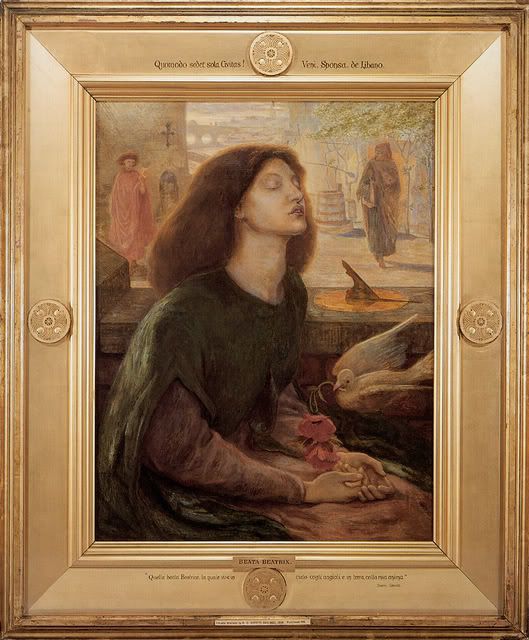
“Apostles of Beauty: Arts and Crafts from Britain to Chicago” is a new exhibit at the Art Institute of Chicago celebrating the Arts and Crafts movement. For those of you who would love to see Dante Gabriel Rossetti's "Beata Beatrix" in the flesh, this is your chance, as it's one of the pieces featured in the exhibit!
"Apostles of Beauty" features 187 "handcrafted, organic works by the movement's most notable practitioners." The pieces in the show are drawn from a variety of artistic disciplines, including ceramics, wood and metalwork, paintings, photographs and textiles.
In its overview of the exhibit, the museum's website calls the Arts and Crafts movement "one of the most politically progressive and aesthetically compelling artistic movements of modern times." It planted the seeds for the sort of critical thinking about modern living that has driven the green movement. Arts and Crafts connected organic thinking and living on a large scale for the first time, and demonstrated that the "beautiful and useful" as William Morris loved to say, were not mutually exclusive. As the museum's website so beautifully puts it:
The Arts and Crafts movement sprang from a rebellion against industrial life and mass-produced objects yet eventually united hand and machine in the service of beauty.
On a side note, it certainly seems like 2009 has been a great year for interest in Arts and Crafts and the Pre-Raphaelites. It would be interesting to know if there are actually more exhibits being held, or if it just seems like there are because I'm always looking for them! (I suppose I could find out if I had the time or discipline to research the issue). Could it be a bit of both?
"Apostles of Beauty" runs now through January 31, 2010.
Read more at The Art Instutute of Chicago's website.
Posted by
Margaret
at
1:53 PM
2
comments
![]()
![]()
Labels: art nouveau, arts and crafts, museums, news, rossetti, william morris
Friday, November 27, 2009
Imperishable Beauty at the Cincinnati Art Museum

For those of you in the Ohio area, there's a new exhibit of Arts Nouveau Jewellery at the Cincinnati Art Museum. Entitled "Imperishable Beauty," the exhibit opened November 17, 2009, and features jewellery designed by René Lalique, Henri Vever, Philippe Wolfers and Tiffany & Co. In addition, textiles by William Morris, posters by Alphonse Mucha, Tiffany glass, silver, and ceramics from the Cincinnati Art Museum’s permanent collection will also be featured in order to give a background for the art movements that influenced these designers. 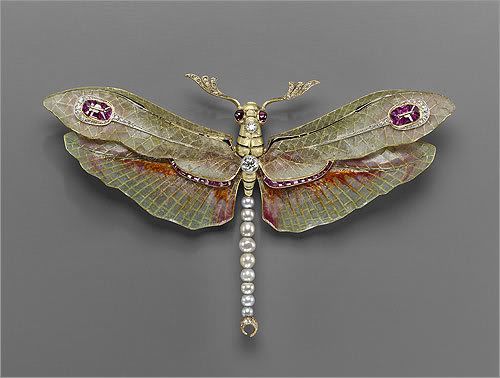 One of the staggering aspects of Art Nouveau jewellery is the realism and detail that the best designers were able to bring to their work. This dragonfly brooch by Belgian artist Philippe Wolfers (Belgian, 1858–1929) is constructed from platinum, gold, enamel, diamond, ruby, and pearl, but it looks so life-like. Beautiful, useful, and true to nature - definitely wearable art!
One of the staggering aspects of Art Nouveau jewellery is the realism and detail that the best designers were able to bring to their work. This dragonfly brooch by Belgian artist Philippe Wolfers (Belgian, 1858–1929) is constructed from platinum, gold, enamel, diamond, ruby, and pearl, but it looks so life-like. Beautiful, useful, and true to nature - definitely wearable art!
The exhibition will run from now until January 17, 2010. For more information, visit the Cincinnati Art Museum website. There are a number of related programmes and events that sound like a lot of fun!
Images courtesy Museum of Fine Arts, Boston. Top image: Orchid brooch, 1901. Georges Fouquet (French, 1862–1957). Gold, enamel, diamond, and pearl.
Posted by
Margaret
at
2:36 PM
5
comments
![]()
![]()
Labels: art nouveau, arts and crafts, museums, news, william morris
Thursday, October 1, 2009
Victoria and Albert Museum's William Morris Print Book
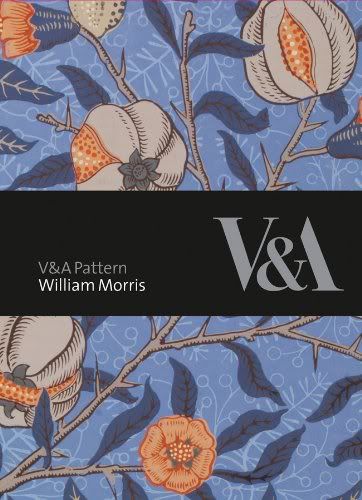
The Victoria and Albert Museum has announced publication of a new William Morris Pattern Book. The book will come with a CD of the pattern images, so that designers can be free to research and modify the designs as they choose.
The collection was put together by Linda Parry, whom many William Morris buffs will immediately recognize as the author of some of the best books on Morris' design work. Parry served as curator of the V&A's 1995 William Morris exhibit, and is one of the world's foremost experts on Morris. Parry also worked as deputy keeper of the Furniture, Textiles and Fashion Department at the V&A for many years.
I just ordered my copy and I can't wait for it to arrive! I'm really curious to see what I can do with the CD--I'm thinking it will be perfect for adapting some of the designs to needlework, etc.
This title is available through The Earthly Paradise Bookstore.
Posted by
Margaret
at
8:55 AM
8
comments
![]()
![]()
Labels: arts and crafts, books, news, william morris
Tuesday, September 8, 2009
Liberty London Shows Flair for Fashion
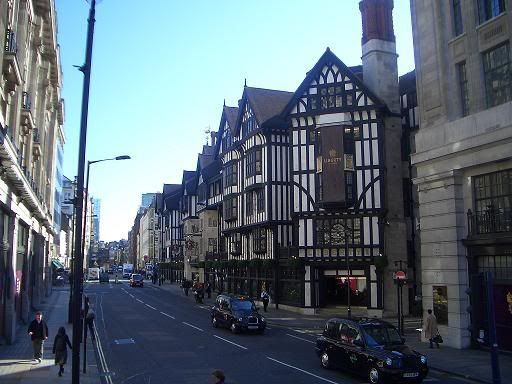
Liberty & Co. has long been associated with the Arts and Crafts movement. William Morris' prints have become almost synonymous with the famous London shop, and Oscar Wilde once commented that Liberty was the “the chosen resort of the artistic shopper.”
The recent economic downturn has been difficult for the London store, and Liberty is responding to market pressures by cultivating a slightly more modern design aesthetic. Liberty's CEO, Geoffroy de La Bourdonnaye, is injecting some high fashion flavour into the store through a relationship between Liberty and Hermès.
The iconic french fashion house will be opening a "pop up" boutique in the centre of the store that will feature Hermès scarves and neckties.
The theme of "romance and rebellion" will be continuing with a series of ready to wear prints created exclusively for Liberty by Rolling Stones rocker Ronnie Wood. Wood, who was last featured on this blog when his daughter married in a Pre-Raphaelite inspired gown, has become respected as an artist in his own right. I particularly enjoyed the print he created for the dress below: 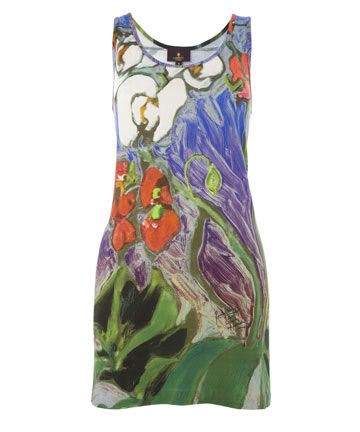
I love Hermès (who doesn't?), and Ronnie Wood's prints do seem like a lot of fun. At the same time, I hope Liberty doesn't lose sight of their fabulous Arts and Crafts heritage in an attempt to remain hip.
Read more at the New York Times
Posted by
Margaret
at
9:06 PM
6
comments
![]()
![]()
Labels: arts and crafts, news, reviews, william morris
Tuesday, August 18, 2009
William Morris and Islamic Art
Journalist Navid Akhtar has taken an opportunity to examine the influence that Islamic design had on William Morris.
Akhtar argues that Morris' designs are "inextricably linked to the curving sinuous arabesques of traditional Islamic Art," pointing out the strong connection between Morris' work and Turkish ceramics and Persian carpets.
Akhtar goes on to argue that Morris was influenced, not only by the aesthetics of Islamic art, but by the principles that guided that art. He even suggests that Morris' famous decorating maxim "have nothing in your house that you do not know to be useful, or believe to be beautiful,"--is drawn from a saying in the Koran that "God is beautiful and loves beauty".
While this might be a bit of a stretch, it's undeniable that Morris and many of his friends in the Pre-Raphaelite Brotherhood were strongly influenced by Islamic design elements (particularly the repetition and symmetry that can be found in many middle-eastern art). Akhter suggests that many of the notions that Morris held dear--such as the importance of social consciousness, usefulness and beauty in every day objects-- were also common to Islamic art.
I think it was very important to Morris that these ideals were universal, but it's also interesting to see that a new generation of Muslim artists using Morris as artistic inspiration. What are your thoughts?
You can listen to the full radio broadcast at the BBC.
Posted by
Margaret
at
8:49 AM
8
comments
![]()
![]()
Labels: architecture, arts and crafts, news, reviews, william morris
Sunday, July 26, 2009
Joke Written by George Bernard Shaw about William Morris Unearthed after 79 Years
BBC News reported yesterday that a researcher has discovered a joke written by playwright George Bernard Shaw in honour of the opening in 1930 of the Hall at William Morris House in Wimbledon. The joke was found written in Shaw's hand on a photograph of himself, and reads as follows:
"William Morris and I preached the gospel of Labour together on many occasions.
"Many respectable persons thought we deserved hanging. I am proud to hang in a hall dedicated to him."
The note was discovered by researcher Peter Walker in a cupboard among the archives of the Wimbledon Labour Party. Walker noted that, "[t]he discovery of this original picture and handwritten joke by one of our greatest playwrights is very exciting."
It's interesting to see that Shaw seems to have had fond memories of Morris. I always knew that they shared similar political views, but they seem to have had a long history together. Both men started as members of the Social Democratic Foundation (SDF), and they actually started the Socialist League together in 1885, together with Eleanor Marx. Small world!
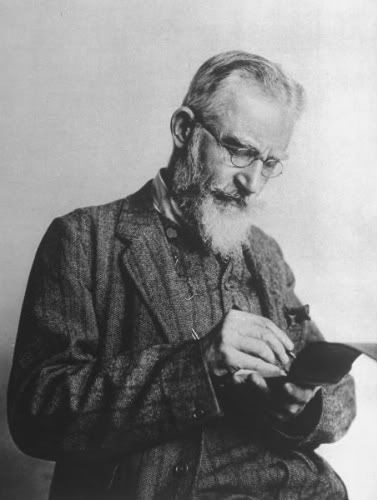
Posted by
Margaret
at
10:36 PM
4
comments
![]()
![]()
Labels: arts and crafts, news, william morris
Thursday, June 25, 2009
Pre-Raphaelite Art at the Delaware Art Museum
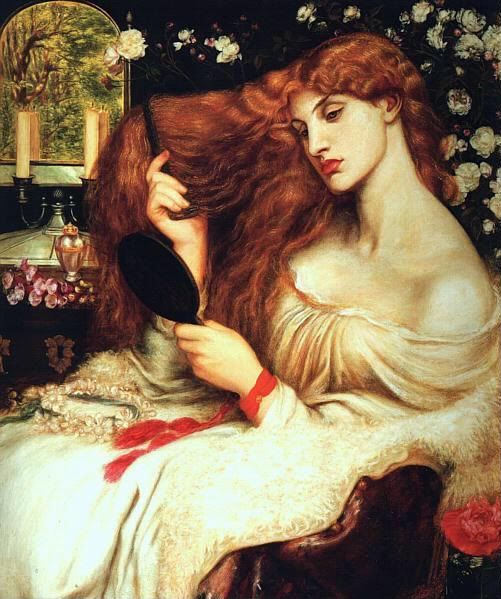
I'm always on the lookout for great Pre-Raphaelite art online, and yesterday I came across the Delaware Art Museum's fabulous Pre-Raphaelite art gallery, which features the collection of Samuel and Mary Bancroft. The Delaware Art Museum has the largest permanent collection of Pre-Raphaelite works in the United States. The museum maintains their collection through the generous support of the aptly-named "Rossetti Circle" of art patrons. I would definitely join if I lived anywhere near Delaware! Anyway, it's a lovely, well put together website with an extensive collection of photos of Pre-Raphaelite art and art objects. I highly recommend taking a moment to enjoy what they have to offer.
I was particularly impressed by the Delaware Art Museum's education packet on the art of the Pre-Raphaelites. It's available for download here. This curriculum package covers the Pre-Raphaelites, William Morris and the Arts and Crafts Movement, The Aesthetic Movement--and pretty much everything else that is important to the study of Pre-Raphaelite Art. It's one of the best resources of it's kind that I have come across, and far superior to many books that I've read on the subject! If you are looking for some more information on the topic of the Pre-Raphaelites, it's definitely a great place to start.
Posted by
Margaret
at
8:22 AM
8
comments
![]()
![]()
Labels: arts and crafts, museums, pre-raphaelites, reviews, rossetti, william morris
Tuesday, November 11, 2008
The End of an Era--Spode Begins Overseas Production of Blue Italian, Then Goes Bankrupt

I've collected Spode Blue Italian since I was ten years old. I have some pretty interesting pieces in my collection, like the Cheese Wedge Dish that I begged for--and received from my dear mother--for high school graduation. People might have thought it was a little odd for a ten year old to begin collecting china, but that's just the way I was! From the time I was young I recognized the beauty of the products and I still remember reading about transfer ware in Victoria Magazine and being fascinated with the time consuming, labour of love involved in creating each piece of porcelain.
So, it seemed natural to use my wedding registry as an opportunity to complete my collection. I set up my registry at Caplan Duval, here in Canada. I ended up waiting over a year due to some mysterious "reorganization" at the Spode factory. Finally, 15 months later, my first shipment of china arrived.
I was completely crestfallen when I opened the box. I hardly recognized the china. It was an odd, almond colour, with an indistinct blue-ish pattern that seemed like a caricature of the original. Moreover, the plates in the 5 piece place setting did not even stack properly with my old set because they were sized incorrectly.
Spot the knockoff: 
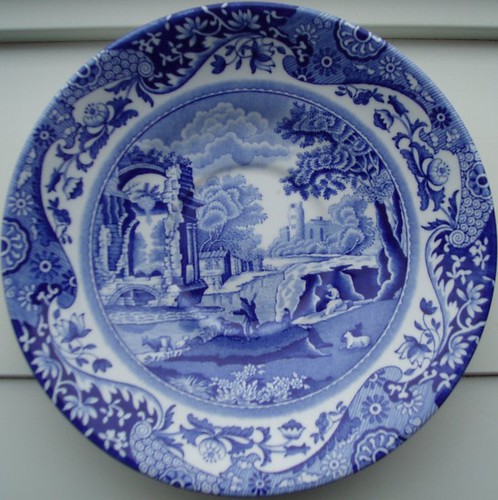

Businesses seem to apply a "one size fits all" solution to economic challenges. Outsourcing is viewed as the universal cookie-cutter response to poor sales. In their letter to my mom, the people at Spode suggested that outsourcing was their only option. For legal reasons, I cannot quote their letter on The Earthly Paradise, but their overall argument was that customers would prefer to purchase Spode products at a lower price, than spend more for Spode that had been made in England.
The next day, we discovered that Royal Worcester, the maker of Spode, was bankrupt. I wonder why!
Outsourcing is a difficult concept for me. I would personally much rather spend twice as much for a quality product made by artisans than a cheap knockoff produced by workers in a foreign factory being paid pennies an hour. I firmly believe that unhappy workers cannot create beautiful work. It doubtless comes from reading too much William Morris, but I firmly beleive in artisan work, and I don't care whether it's profitable or not! Morris and Company was always a profitable business, in that it did not lose money. But it also did not make the kind of obscene profits that most business today seem to believe they require in order to compete in the global marketplace.
I continue to hope that whichever corporation purchases Royal Worcester has better businesses ideas, but I'm not holding my breath. It seems that the world's former luxury goods producers have completely lost sight of what made their products worth having in the first place.
You can read more about Spode/Royal Worcester's financial difficulties in the Tri-City Herald.
Posted by
Margaret
at
10:10 AM
39
comments
![]()
![]()
Labels: arts and crafts, decorating, william morris

